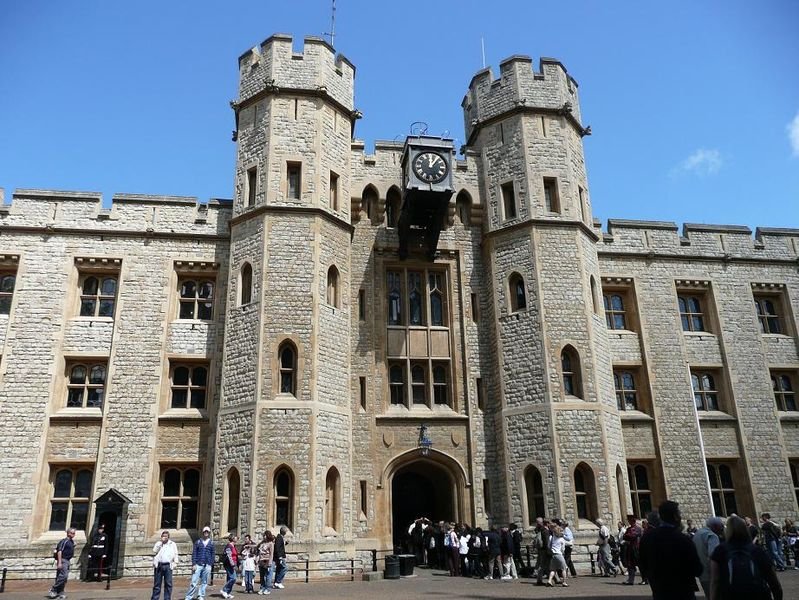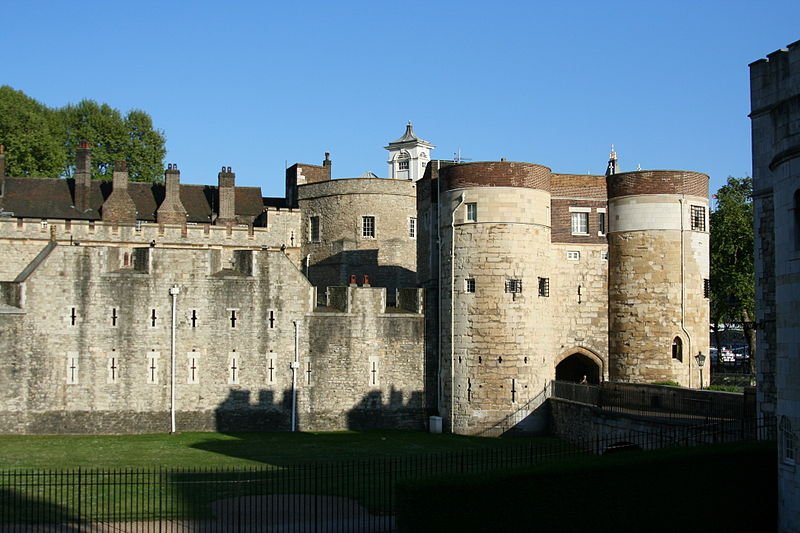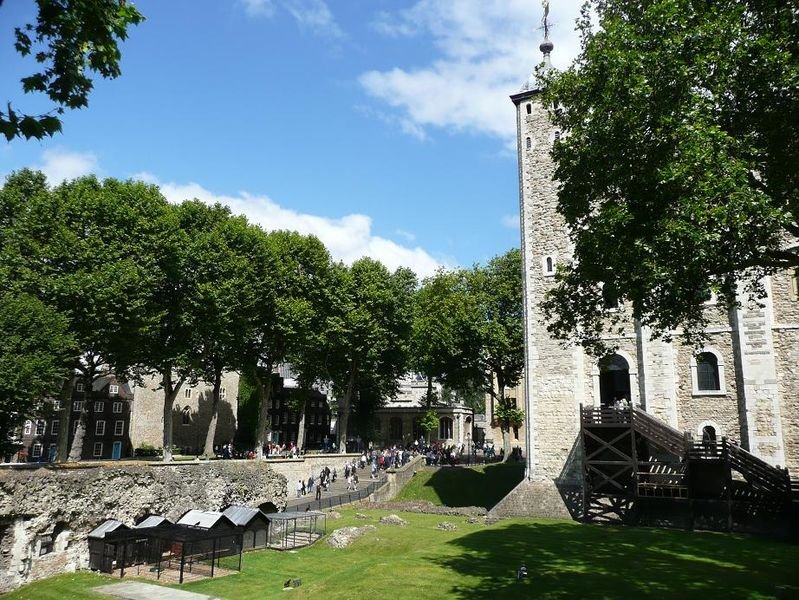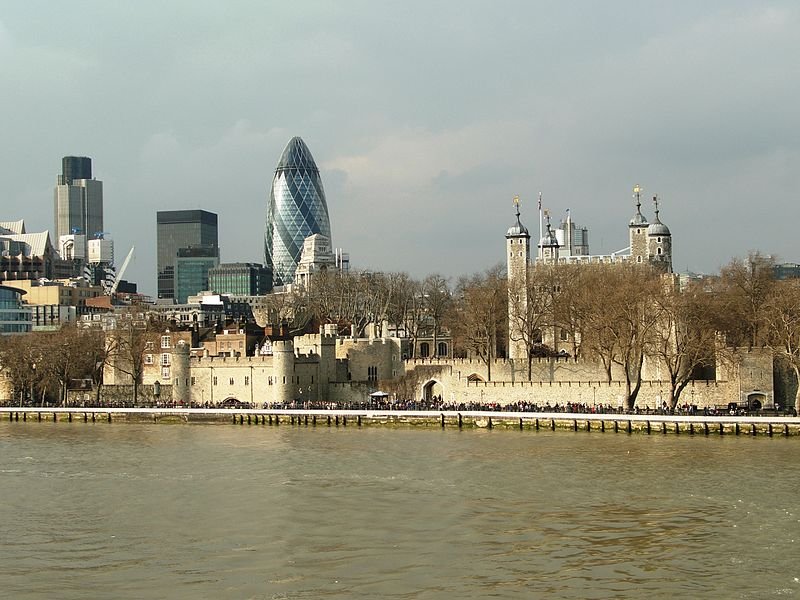
Tower of London
When one talks about the Tower of London, one usually refers to the White Tower, the original stark square fortress built by William the Conqueror in 1078. However, the Tower is in fact a complex comprising several buildings set within two concentric rings of defensive walls and a moat.
The Tower's main purpose was to act as a fortress, a royal palace, and a prison (a place where high profile people such as noblemen and royalty are imprisoned). This last use has led to the phrase "sent to the Tower" meaning to be imprisoned.The Tower is also the place of execution and torture, as well as an armoury, a treasury, a zoo, a mint, a public records office, an observatory, and since 1303, the home of the Crown Jewels of the United Kingdom.
 Tower of London
Tower of LondonSource: https://commons.wikimedia.org/wiki/File:Londres_310..jpg
Author: Simdaperce

The Tower of London came into being in 1078 when William the Conqueror ordered the White Tower to be built inside the Southeast angle of the City walls adjacent to the River Thames. It has a twofold purpose: to protect the Norman conquerors from the inhabitants of London, and to protect the City of London from external invaders. William ordered the Tower to be built of Caen stone, which he had specially imported from France. Gundulf, the Bishop of Rochester, was appointed as the architect.
Some writers including Shakespeare, in his play Richard III, have ascribed the construction of the Tower of London to the Romans, stating that it was built by Julius Caesar. This is but a myth.
 Tower of London
Tower of LondonSource: https://commons.wikimedia.org/wiki/File:023SFEC_TOWER_OF_LONDON-200705.JPG
Author: Steve F-E-Cameron

In the 12th century, King Richard the Lionheart enclosed the White Tower with a curtain wall and had a moat dug around it. He tried to get the moat filled with water from the Thames, but was unsuccessful. Then, in the 13th century, King Henry III succeeded when he used a Dutch moat-building technique. He strengthened the curtain wall, breaking down the city wall to the east, despite protests of the citizens of London. He transformed the Tower into a major royal residence and had palatial buildings constructed within its walls.
King Edward I built the outer curtain wall of the Tower between 1275 and 1285, completely enclosing the inner wall. This creates a concentric double defence for the Tower. He filled in the old moat and built a new one around the new outer wall.
The Tower remained a royal residence until the time of Oliver Cromwell, who demolished the old palatial buildings.
 Tower of London
Tower of LondonSource: https://commons.wikimedia.org/wiki/File:Londres_298..jpg
Author: Simdaperce

A Royal Menagerie was established at the Tower in the 13th century, during the reign of King John. It was probably stocked with animals from an earlier menagerie started by King Henry I in 1125 by Henry I. The menagerie had lions, leopards, lynxes and camels. 1235 is documented as its year of establishment. That's the year King Henry II received three leopards (though they may actually be lions) as a wedding gift from Frederick II, the Holy Roman Emperor. In 1264, the beasts were moved to the Bulwark, which was then renamed the Lion Tower, near the main western entrance. It was opened as an occasional public spectacle during the reign of Queen Elizabeth I. A lion skull kept there was radiocarbon dated to between 1280 and 1385, making it the earliest medieval big cat known in Britain.
In the 18th century the Royal Menagerie was open to the public and an admission fee of three half-pence or the supply of a cat or dog for feeding to the lions was charged. This was where William Blake may have seen the tiger which inspired his poem The Tyger. The menagerie's last director was Alfred Cops. He took over in 1822 and found the collection was in a dismal state. He attempted to restock it, even producing an illustrated scientific catalogue. However, by that time, the new London Zoo was about to open in Regent's Park, and when it did, the animals were moved there. The last animal left the Royal Menagerie in 1835. Much of Lion Tower was demolished soon after, although the Lion Gate remains.
 Tower of London
Tower of LondonSource: https://commons.wikimedia.org/wiki/File:Londres_-_Torre_de_Londres_i_City.JPG
Author: Josep Renalias

Ravens have been kept at the Tower for centuries. According to tradition, King Charles II had ordered their removal following complaints from John Flamsteed, the Royal Astronomer. However, they were not removed when the king was told a legent that if the ravens ever leave the Tower of London, then the White Tower, the Monarchy, and the entire Kingdom would fall. Superstition or not, Charles was not prepared to take the chance, and instead had the observatory moved to Greenwich.
The Crown Jewels have been kept at the Tower of London since 1303, after they were stolen from Westminster Abbey. Most were recovered afterwards. After the coronation of King Charles II, the Crown Jewels were locked away and shown for a fee paid to the custodian. This arrangement ended when Colonel Thomas Blood stole the Crown Jewels after having bound and gagged the custodian. After that, the Crown Jewels were kept in the part of the Tower known as Jewel House, with armed guards defending them. During World War II, they were secreted out of the Tower, and were reportedly kept in the basement vaults of the Sun Life Insurance company in Montreal, Canada, along with the gold bullion of the Bank of England. There were also tales that they were kept in the Round Tower of Windsor Castle, or at the Fort Knox Bullion Depository in the United States. The most likely place, however, should be Windsor Castle, as the Crown Jewels are not supposed to leave the country.